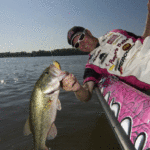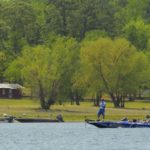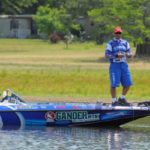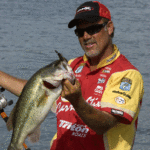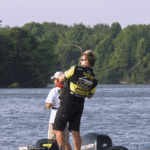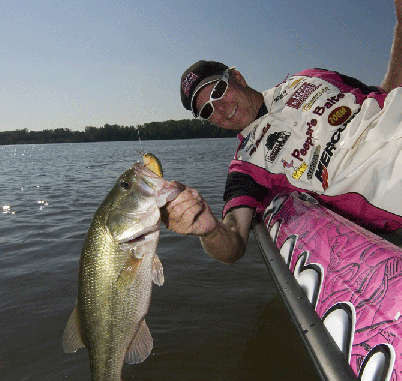
The world’s top bass pros descend on Toledo Bend this month. Here is how they’re likely to decode the lake as they chase the $100,000 top prize.
Dean Rojas won last year’s BASS Elite Series stop at Toledo Bend with 70.15 pounds of bass caught over four days of fishing.
Rojas reportedly found fish on beds and caught some on grass flats by fishing a Big Bite Baits WarMouth (a soft plastic that imitates a swimming bream) and a SPRO Hydropop topwater popper on the edges of the grass.
These kinds of patterns will be long gone when the top bass pros stop at the Bend during the June 7-10 Elite Series tournament, local anglers have predicted.
“If a guy shows up expecting to do what he did last year, he’s going to have a rude awakening,” Roanoke-based BASS Elite Series professional angler Dennis Tietje said. “That’s because the tournament was held in April last year, and it’s in June this time around.
“We could physically see everything we fished last year, but since the lake has come up, this will not be a visible-cover tournament.”
Tietje, who is not fishing the Elite Tournaments this year due to a medical exemption, reported that Toledo Bend is in really good shape right now, and that by the time the best anglers in the world converge along the Louisiana/Texas border, bass will have already recovered from the spawn and be out in deep water chasing the bigger schools of shad.
But that doesn’t mean anglers won’t be able to target bass in shallower water. In fact, Tietje predicted that tournament anglers would be able to catch fish anywhere from 2 feet of water all the way out to 30 feet.
“It’s going to depend on who gets on the bigger schools of fish, and we all know the bigger schools of fish aren’t going to be in the shallows,” Tietje said. “I think a guy who can put together a combination of an early shallow-water bite with a mid-morning deepwater bite could win the tournament.”
In Tietje’s estimation, another reason this year’s tournament will be completely different is because bass are going to be really food-oriented rather than spawn-oriented.
In other words, find the food and you’ll find the bass.
That means two primary possibilities stick out for June: Either anglers will find schools of shad on the deep river channels, or they will find them around the deepwater grass beds.
Where any angler chooses to fish will be based on what he determines to be his particular strength.
“The deep grass is naturally on the south end of the lake where the water is clearest,” Tietje said. “There’s some 20- to 22-foot grass on the outside line right now, and the inside line is about 12 feet deep.”
How an angler approaches the deep grass will depend on how they like to fish. If Tietje was fishing the tournament, he said he would concentrate on the outside grass line because he considers himself to be a better cranker and flipper.
“Whether one of these guys fishes the inside line or the outside line, it’s really going to come down to whoever can find that sweet 10-yard stretch,” Tietje continued. “Those bass will bunch up this time of year, and whoever can find that magic spot can become a hero.”
The other grass pattern that might play out is a very early topwater bite around shallow grass. Tietje didn’t see this as being anything more than an opportunity to catch a kicker fish or two before heading out to deep water, but that might be all it takes to rack up a big sack of fish.
As for the other deepwater bite, there are deep channel holes from one end of Toledo Bend to the other, with the ones up north being shallower than those down south.
While channel holes could be a factor anywhere in the lake, Tietje believes those up north could be the ones that pay off.
“The guys who find the right holes up north will be a strong factor in this tournament,” he said. “These are the kinds of spots where all your deepwater anglers are going to go.. — guys who like to fish Carolina rigs, big worms and even the drop-shot guys.”
How an angler fishes the channel holes is entirely dependent on whether the bass have pulled up to eat or whether they are not feeding at all.
If the fish are feeding, Tietje says that’s the time to throw some of the big, deep-diving crankbaits like the DD220-type lures.
However, being able to catch bass when they aren’t actively feeding on the channel will be important to staying on the bite all day long.
“If they’re not eating, the anglers are going to have to throw the football jigs, big worms — your typical summer patterns,” Tietje explained. “And although I don’t think it would ever be won on a drop-shot, that’s just the kind of thing that might save a limit and keep somebody in the tournament if he’s struggling one day.”
Tietje estimated it would take over 80 pounds over four days to win the tournament, but when pushed for a specific prediction, he almost immediately suggested 84 pounds.
If his prediction plays out, that means the winner will have to average over 20 pounds a day.
“That time of year, if a guy gets on the right school, he could push a 28- or 29-pound sack for one day,” Tietje said. “The chances of that for four days: not going to happen.
“But I can tell you this: Whoever gets in the right school of feeding fish is going to find them bunched up, and all (of them will be) big. That’s the guy who’s going to win.”
Just because Rojas caught them shallow last year doesn’t mean he’s automatically out of the running this year. However, just like everybody else, he’s going to have to adjust to current conditions rather than relying on prior knowledge.
If he can do that, perhaps Rojas can defend his title. If he can’t, it’s anybody’s game in a completely different Toledo Bend tournament.
